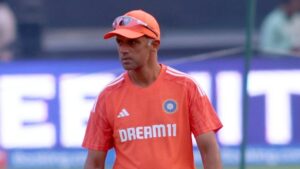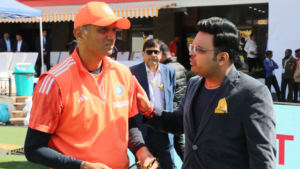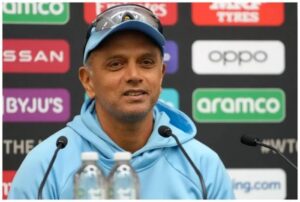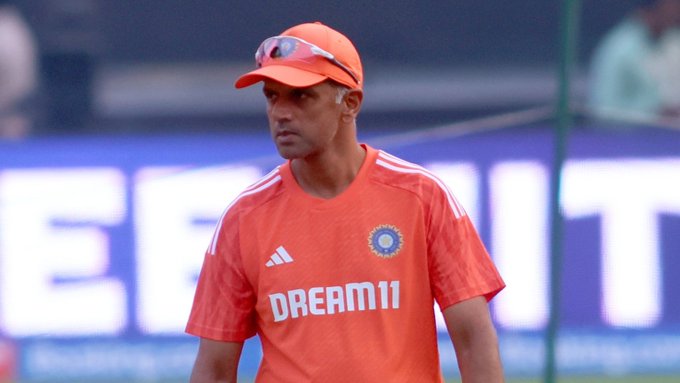
The Caribbean islands might stir contrasting emotions for Rahul Dravid. In 2006, he was the captain when India beat the West Indies in their backyard after 35 years. The following year, under his leadership, the team made a disastrous exit from the World Cup. On perhaps his last trip to those charming islands as a part of the national team, Dravid would seek a reversal of fortunes.
Criticised in his early days as India coach for being unable to match the standards set by his predecessor Ravi Shastri, Dravid has actually had a decent three years at the helm. The team haven’t won an ICC trophy under his guidance yet, nor has it won something remarkable away from home. But the batting great has handled a delicate and potentially volatile period rather well.
One has to understand that the expectations of the Indian team — and hence the coach — have increased manifold over the years. A World Cup semi-final or even a final is not deemed a success in India these days. An appearance in a World Test Championship final is considered a failure unless the team has won it. Dravid should not be judged on the basis of defeats in those last games.
Soon after Dravid took charge in 2021, the team dynamics changed following Virat Kohli’s decision to step down as captain. There was talk of tension in the dressing room, spiralling injury issues and an incredibly busy calendar, which necessitated the formation of two teams to play simultaneously in two corners of the world. Any of these could have been a recipe for disorder.
For the Latest Sports News: Click Here

Dravid didn’t seem proactive enough, or so was it portrayed in sections of the media, but he didn’t buckle under pressure. A person who prefers the back seat, he went about his task of stabilising the ship and rebuilding the team in his own quiet manner. The results were not immediately obvious, but throw in two ICC trophy finals and a robust bench — he has done his job.
The focus immediately is on the T20 World Cup and so it should be. Dravid, the coach, will to a large extent be judged by how the team fares in the USA and West Indies over the next few weeks before he quits the job and goes back to his family. It will still perhaps be a bit unfair to evaluate him solely on the basis of that, without looking at the phases he has navigated the team through.
The England series earlier this year was an example. India played almost at half-strength and won 4-1 after losing the first Test. They had to field five debutants and a few others with a combined experience of around 15 Tests. There was no commotion or panic. Rohit Sharma led commendably, things happened smoothly and the results were there to see. The coach must have played a part in this.
A believer in the theory of continuity, which says that a newcomer can’t be discarded unless he fails over a minimum number of matches, Dravid & Co persisted with Rajat Patidar for three Tests despite minimal returns. Why? Because the principle at play was there would be no knee-jerk reaction. This gives players a sense of security, instead of compounding the pressure they are already under.

It helped that Dravid was overseeing the U-19 and India A set-ups as the National Cricket Academy director before being appointed India coach. The continuity process had started back then. He had first-hand knowledge of who is made up of what. He knew their temperament and how they reacted to situations. This helped him deal with resources and now, India have an enviable reserve bench.
Dravid was part of the think-tank which decided that there was no need for an additional batter after Hardik Pandya got injured during last year’s World Cup. Or, that Ravichandran Ashwin had to be benched. These were tough calls, which attracted flak initially but paid off later. Taking those decisions under pressure at that point in time needed steel. And Dravid has some of it, we know.
In terms of tangible results, Dravid will not come close to many who preceded him. But in terms of long-lasting impact and future gains, he might have contributed silently and significantly. It’s possible that the person next in line will reap some of these benefits. In that case, the real gains of having Dravid as the coach will become visible after he quits.
However, until then, there is business to be done on the pristine Caribbean shores, where Dravid has seen the highs and lows of life as a cricketer and captain. Now, as a coach, he is on the cusp of something different. The team’s failure will brand him a flop show. Success will immortalise him. The reality will be somewhere in between, and that will be Dravid’s true legacy.
Also Read: Focus on team combination as India open their T20 World Cup campaign against Ireland




